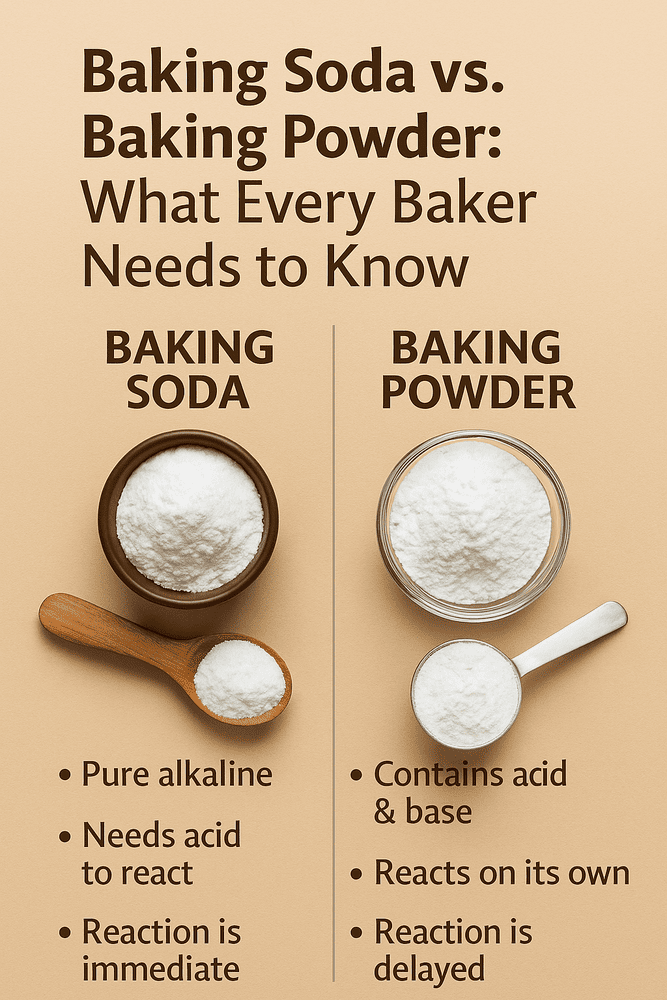Have you ever wondered why some cake recipes call for baking powder, others for baking soda, and some use both? These two ingredients play very different roles in baking — with distinct reactions, uses, and results. Understanding how and when to use each one can completely change your outcomes in the kitchen.
In this article, you’ll learn how baking soda and baking powder work, when to use them, how to substitute them properly (with caution), and which common mistakes to avoid. If you read our previous article, “Mixing Matters: How to Beat Your Batter for the Best Texture”, you already know how mixing affects structure. Now, let’s dive into what really makes your cake rise and stay light.
What is Baking Soda?
Baking soda (also known as sodium bicarbonate) is a pure alkaline powder. It reacts with acidic ingredients like lemon juice, vinegar, yogurt, buttermilk, or natural cocoa powder, producing carbon dioxide gas. That gas forms air bubbles in the batter and makes your cake rise. But take note: this reaction is immediate. So when you use baking soda, your batter should go into the oven right away, before the gas escapes.
Baking soda can also help brown your cake more and balance out the sharpness of acidic ingredients. However, if used in excess or without enough acid to neutralize it, it can leave a bitter, metallic aftertaste — something every baker wants to avoid.
What is Baking Powder?
Baking powder is a compound leavening agent, usually made from baking soda + one or more dry acids + a stabilizer like cornstarch. It’s designed to release gas in two stages: once when it meets liquid, and again when heated. That’s why most store-bought versions are called double-acting baking powders.
This makes baking powder more stable and predictable, making it the go-to choice in vanilla cakes, basic sponge cakes, or recipes that don’t contain acidic ingredients. It gives you more time to prep, since the reaction doesn’t happen all at once.
When Should You Use Each One?
Use baking soda when:
- Your recipe includes acidic ingredients (yogurt, lemon juice, honey, natural cocoa)
- You want a fast and strong rise
- You need more browning and a balanced flavor
Use baking powder when:
- Your recipe has no acidic ingredients
- You want a light, soft texture with a gentler rise
- You need more prep time before baking
Some recipes use both baking soda and baking powder. This happens when the amount of acid in the recipe isn’t enough to fully activate the baking soda, so baking powder is added to guarantee the rise. You’ll often see this in chocolate cakes made with natural cocoa powder — which is acidic — but also includes other ingredients that require balance.
Common Mistakes with Leavening Agents
- Using expired baking powder: Always check the date. Old baking powder loses its strength. Test it by placing a teaspoon in hot water — if it doesn’t bubble, it’s no good.
- Adding baking soda without enough acid: This results in a soapy taste and pale cake. Always respect the recipe’s chemistry.
- Too much leavening = disaster: Adding extra baking soda or powder won’t make your cake taller — it might rise too fast and collapse in the center, leaving a strange taste.
- Waiting too long with baking soda-based batters: Since the reaction is instant, the batter must go in the oven quickly.
- Confusing the measurements: Baking soda is much stronger than baking powder. Typically, use 1/4 to 1/2 teaspoon of baking soda for every teaspoon of baking powder.
Can You Substitute One for the Other?
In emergencies, you can substitute baking powder with baking soda if your recipe contains acid — but adjustments are needed:
- 1 teaspoon baking powder = 1/4 teaspoon baking soda + 1/2 tablespoon lemon juice or vinegar
Replacing baking soda with baking powder isn’t as effective, and the results might be flatter and less browned. It also requires changes to your recipe’s liquid ratio.
When in doubt, stick to the original recipe or use the correct leavening agent. Baking is chemistry, and small changes can lead to big differences.
How It Connects with Other Techniques
Using the right leavening agent is deeply connected to how you mix your batter (article #11), your choice of liquids (see “Milk, Yogurt, and More”), your oven temperature (article #10), and the type of flour you use (see “Flour Power”). Baking is a system — having the right ingredient won’t help if you overmix or underbake.
Final Thoughts
Understanding the difference between baking soda and baking powder isn’t just a technical detail — it’s a foundational skill for anyone serious about baking. With this knowledge, you’ll be able to troubleshoot recipes, prevent flat cakes, and even develop your own variations with more confidence and creativity.
In the next article, we’ll answer a question many beginners have: “Why Do Cakes Crack on Top?” This very common issue has simple causes — and even simpler solutions — often linked to the exact leavening agents we covered here.
Until then, keep learning, testing, and of course, baking with joy. Your cake deserves it — and so do you.
